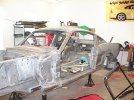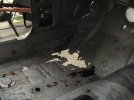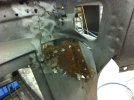There are several rusted areas on classic cars that you cannot access to blast or remove rust. What are some best practice options to treat the rusted metal behind a support panel on the inside of a fender or between the inner and outer hood panels? I can remove all the rust pits that I see, but how do we help slow down the rust inside areas we can't get to? What are practical effective solutions for this? Thanks in advance.
You are using an out of date browser. It may not display this or other websites correctly.
You should upgrade or use an alternative browser.
You should upgrade or use an alternative browser.
How to Treat and protect rusted Metal (under fender support panel or between inner and out hood layers
- Thread starter RHR
- Start date
You can't 100%, unless you take the seam apart and then put it all back together, poke around here and you'll see some that have done just that.
Fortunately, in tight spots with no air and no water, rust progresses slowly, so epoxy to the edges, maybe flowing under, good seam sealer and things should last awhile.
Heck I've been working on my project so long, it will most likely show no rust until I'm gone. May not get it done before I'm gone. Have to weigh out the trade offs, lol.
Edit to add, I had mine dipped to try and get that rust, but it was still there when I cut into it. I've seen some on here use electrolysis, and then there still be rust when it gets cut into.
Fortunately, in tight spots with no air and no water, rust progresses slowly, so epoxy to the edges, maybe flowing under, good seam sealer and things should last awhile.
Heck I've been working on my project so long, it will most likely show no rust until I'm gone. May not get it done before I'm gone. Have to weigh out the trade offs, lol.
Edit to add, I had mine dipped to try and get that rust, but it was still there when I cut into it. I've seen some on here use electrolysis, and then there still be rust when it gets cut into.
MJM
Promoted Users
Unless the panels on the vehicle are completely disassembled, ie; skins removed from skeletal frames, there is no way to protect areas with epoxy, etch, primer or any type of paint. However, most vehicles, if not all, built during the 60's had the metal conditioned for rust prevention. It might not have been the best rust prevention method but, it was the choice used from the manufactures back then. I can't speak for pre 1960's, don't know anything about the process used back then. With that said...................
The best one can do in my opinion when "not" disassembling panels by spot weld removal, is apply epoxy either spraying, brushing, rolling or even pouring it on and letting it absorb it's way into cracks and creases. It's my understanding that lite surface rust can be slowed down or halted from continuing to spread once covered in epoxy.
Here's another way to look at it. You can have a vehicle dipped to remove paint and rust, that process is going to remove a percentage of rust, if not all of it, that has formed between spot welded panels. How to protect those areas without disassembling them? As already stated........spray, brush, roll or pour epoxy over those area's.
From my point of view, I would never dip a vehicle that I wasn't willing to disassemble panels via spot weld removal so those areas could be properly rust protected. The manufactures rust protection is better than nothing. My 50 plus year old car is proof of that. I have some area I can see have discoloration, that is the starting point of which rust will continue to form. I have simply cleaned it up the best I can and coated it with epoxy. Those areas will last another 50 plus years if not longer. I can say without hesitation my car is rust free.
The best one can do in my opinion when "not" disassembling panels by spot weld removal, is apply epoxy either spraying, brushing, rolling or even pouring it on and letting it absorb it's way into cracks and creases. It's my understanding that lite surface rust can be slowed down or halted from continuing to spread once covered in epoxy.
Here's another way to look at it. You can have a vehicle dipped to remove paint and rust, that process is going to remove a percentage of rust, if not all of it, that has formed between spot welded panels. How to protect those areas without disassembling them? As already stated........spray, brush, roll or pour epoxy over those area's.
From my point of view, I would never dip a vehicle that I wasn't willing to disassemble panels via spot weld removal so those areas could be properly rust protected. The manufactures rust protection is better than nothing. My 50 plus year old car is proof of that. I have some area I can see have discoloration, that is the starting point of which rust will continue to form. I have simply cleaned it up the best I can and coated it with epoxy. Those areas will last another 50 plus years if not longer. I can say without hesitation my car is rust free.
Last edited:
Yes, over the years I've seen several cars that were dipped and ecoated after. I haven't looked lately. After cutting panels off my car that was dipped, I'm pretty confident that no currently available/practical dipping method would remove all the between panel rust, and even if you ecoated, it would just end up ecoating over some rust.Here's a good question to be asked...................are there any shops that a vehicle can be dipped for rust protection, just like the manufactures do?
My plan for unreachable areas behind panels and in seams included a heavy application of Ospho on the insides of my doors, fenders and hood, etc. I followed the neutralizing procedure as well in those areas when washing it off with water. (will add dawn next time). Air dried until all moisture was gone. Next is to remove all signs of rust that I can get to with rotory sander 80 g, 1/4" end brush, spot blaster, dental pick, etc until all signs are gone inside and outside of metal. Then to protect the hidden areas, I will spray, brush and pour epoxy into the hidden areas to try and cover it all to seal out the moisture. My thought is that the surfaces have been converted to iron phosphate and coating with epoxy will slow down the progression of the rust but not stop it. This is the best I've been able to come up with. Please share if you have a better way that does. not include taking the components apart.
Treeslayer
Mike
what about amber body wax? maybe some could creep in the cracks? i have also heard of spraying used oil but that seems messy. of course any of this after paint.
'68 Coronet R/T
Oldtimer
Sometimes the only way to get all the rust out is to remove the skin. This is the hood of my GTX.
Drilled out the spot welds and then removed the support structure.

You can see in this picture the how well media blasting cleans the metal. It also preps it for epoxy.


Drilled out the spot welds and then removed the support structure.
You can see in this picture the how well media blasting cleans the metal. It also preps it for epoxy.
MJM
Promoted Users
There are two in my local area, and three more within 300 miles. There dip tanks are about 20' long.
Body dip
Now I know, thank you.
Only question left would be, can epoxy, especially SPI epoxy, be sprayed over the rust prevention coating after dipping?
To me, this would be the ultimate way for rust prevention.
MJM
Promoted Users
Yes, over the years I've seen several cars that were dipped and ecoated after. I haven't looked lately. After cutting panels off my car that was dipped, I'm pretty confident that no currently available/practical dipping method would remove all the between panel rust, and even if you ecoated, it would just end up ecoating over some rust.
Well there it is, proof dipping a vehicle will not completely remove rust between panels. So my assumption that not dipping will prolong areas between metals that had been dipped for rust proofing.
Like I stated earlier, I'd rather leave the factory rust proofing between panels than remove it, and not being able to fully protect it without separating the panels.
68's hood repair is a perfect example of a 100% correct rust removal and future rust prevention.
MJM
Promoted Users
It shouldn't be surprising, blasting doesn't get it either.
This is true but, blasting doesn't remove factory rust protection between panels where dipping a vehicle can.
It would be interesting to see the results using two same year models with close to the same rusting issues. Dip one, blast one. In 25 years crack open some spot welded panels and see which one accelerated the rusting phenomenon. I'm going with dipped would have deeper rust vs the blasted model.
'68 Coronet R/T
Oldtimer
On tight seam areas, like inside of doors, I remove as much of the undercoating as possible using a heat gun and scraper.
After that I apply Ospho with a paint brush where I can reach and work it into the tight spots. In some areas I use a spray bottle and just soak it real well.
After that I apply Ospho with a paint brush where I can reach and work it into the tight spots. In some areas I use a spray bottle and just soak it real well.
theastronaut
Promoted Users
I'd be hesitant of using acid in seams that aren't disassembled. It seems to accelerate rust if it's not all removed/neutralized in my experience.



